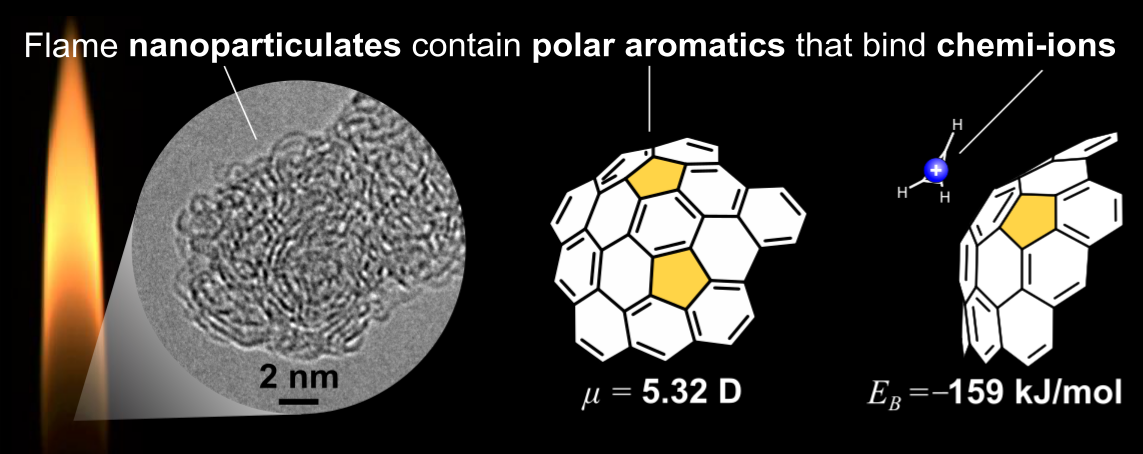Technical Report 207, c4e-Preprint Series, Cambridge
Flexoelectricity and the formation of carbon nanoparticles in flames
Reference: Technical Report 207, c4e-Preprint Series, Cambridge, 2018
- Curved polycyclic aromatic hydrocarbons are quantified in carbon nanoparticles early in a diffusion flame.
- >62.5% are found to contain internal pentagonal rings at 10 mm above the burner.
- The polarity of a curved arene suggested from the microscopy is 5.32 debye, which is significant.
- Electronic structure calculations reveal strong binding between this polar species and chemi-ions, suggesting a potential nucleation mode.
 The formation of carbon nanoparticles in flames involves a nucleation step that remains poorly understood. Experimentally, carbon nuclei formation is known to depend strongly on the electrical aspects of combustion but modes of interaction between charged species in the flame and carbon precursors have yet to be found. We present evidence for flexoelectrically polarised aromatics contributing to carbon nanoparticulate nucleation. We imaged the nascent nanoparticles using high resolution transmission electron microscopy, which revealed that the majority of aromatics in the early carbon nanoparticles are fullerene-like and curved. The curvature induces a significant molecular flexoelectric dipole moment in the polyaromatic hydrocarbons. This electric polarisation allows these molecules to strongly interact with chemi-ions produced during combustion, which we demonstrate using electronic structure calculations. The results indicate that the physical interaction between fullerene-like polar aromatics and chemi-ions is critically assisting the nucleation, and opens a new route to reduce pollution and improve flame-produced nanomaterials.
The formation of carbon nanoparticles in flames involves a nucleation step that remains poorly understood. Experimentally, carbon nuclei formation is known to depend strongly on the electrical aspects of combustion but modes of interaction between charged species in the flame and carbon precursors have yet to be found. We present evidence for flexoelectrically polarised aromatics contributing to carbon nanoparticulate nucleation. We imaged the nascent nanoparticles using high resolution transmission electron microscopy, which revealed that the majority of aromatics in the early carbon nanoparticles are fullerene-like and curved. The curvature induces a significant molecular flexoelectric dipole moment in the polyaromatic hydrocarbons. This electric polarisation allows these molecules to strongly interact with chemi-ions produced during combustion, which we demonstrate using electronic structure calculations. The results indicate that the physical interaction between fullerene-like polar aromatics and chemi-ions is critically assisting the nucleation, and opens a new route to reduce pollution and improve flame-produced nanomaterials.
Material from this preprint has been published in The Journal of Physical Chemistry C.
PDF (5.0 MB)



